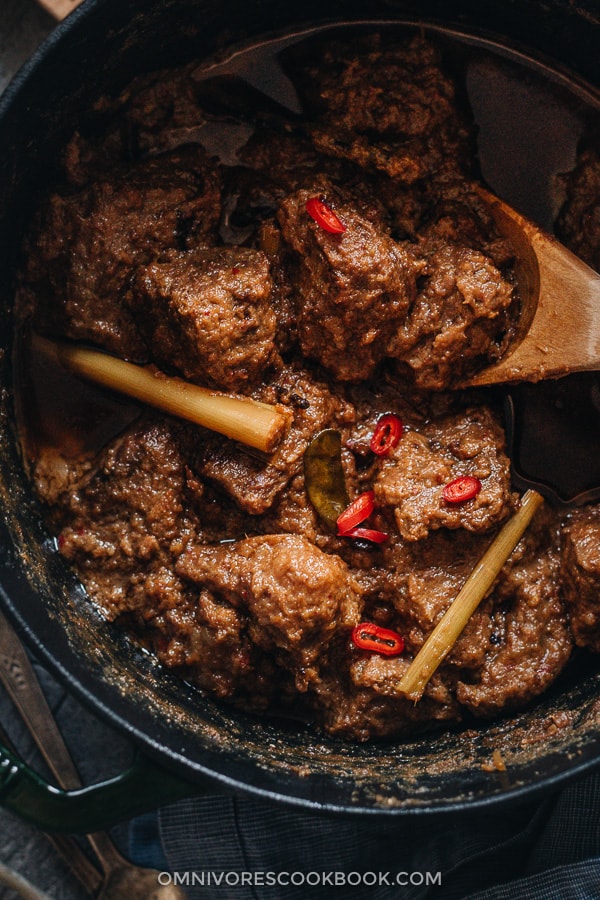This beef rendang recipe yields buttery, juicy beef smothered in a thick, rich, caramelized, aromatic curry sauce. Learn how to make authentic Indonesian beef rendang in your own kitchen with an easy approach. You can also use a slow cooker to make this recipe. {Gluten-Free}

The slow-cooked king of all curries, beef rendang, should definitely be on your ‘I can make this’ list.
Originating in West Sumatra, Indonesia, this spicy, creamy, and infinitely rich beef stew has an incredible depth and complexity of flavor. Cooked with coconut milk and an assortment of southeast Asian spices until the meat is meltingly tender, your kitchen will smell like heaven while the stew simmers. As the coconut milk and liquids reduce, the outcome is a pot of beautiful golden brown curry, crisping up the meat until you are left with almost caramelized beef chunks. This sumptuous dish is definitely suitable to serve as a centerpiece for your weekend dinner party!
The ingredient list might look super long, but the cooking is quite straightforward and doesn’t require a lot of active prep time. You will need to take a trip to the Asian grocery store to source the fresh ingredients for the curry paste, but the result is totally worth it.
Traditionally cooked in a giant pot overnight, my recipe uses the stovetop method. If you wish, you can absolutely use your slow-cooker to make the dish.

Cooking notes
1. Which cut of beef to use
The key to creating tender and juicy braised meat is to use a well-marbled cut. I picked a fatty cut of round roast at Whole Foods and the result was amazing. The beef got buttery tender at the end of braising. Chuck roast is also a great cut for braising, and I noticed that it takes slightly less time to cook. Depending the specific grocery store, sometimes you can find nicely marbled short rib, which is also a perfect choice. If you’re looking for a cheaper option, a fatty cut of brisket is not a bad idea. Although it might take longer to cook.
My least favorite cut is stew meat. It is simply too lean to make a great stew. Although once in a while, I see fatty stew meat at the store and I do purchase it in that case.
2. Fresh ingredients matter
The key to making great beef rendang is to make the curry paste using fresh ingredients. Ingredients such as lemongrass, galangal, and kaffir lime leaves are quite hard to find. You will definitely need to run to the Asian market to source them. Sometimes you might find frozen lemongrass and galangal at a grocery store (I remember seeing them in Central Market when I was living in Austin).
It know it sounds like a lot of trouble. But once you blend all the herbs into a paste, you will thank me because the smell will be amazing.

3. One word on blending the curry paste
I originally used a small food processor that came with my immersion blender. It didn’t work out so well because the herbs were still quite chunky after blending. I had to use my Vitamix blender to finish it up at the end. The problem is, the Vitamix doesn’t work when the quantity of ingredients is too small. I did add some extra veggie broth into the mix so the blender would work properly. The result was a very smooth curry paste. This, in turn, yields a smooth sauce at the end of braising, so you won’t bite into any unexpected chunks of herbs.
I highly recommend you blend the paste in your blender, if you have one, to yield a silkier curry paste.

3. Toasted coconut
Authentic beef rendang uses Kerisik, which is a coconut paste commonly used in Indonesian dishes. To make Kerisik, you need to grate fresh coconut, fry it, and then grind it into paste. It’s way too much work to make it from scratch.
In this recipe, I bought shredded coconut at the grocery store and toasted it until golden. This will save you so much time and the result is really good.

4. Tamarind paste
Tamarind paste is made from the fruit of tamarind trees. Tamarind paste tastes sour, citrusy, savory, with a hint of smokiness and caramel taste. It’s a key ingredient in many southeast Asian dishes, such as this Thai-style Veggie Curry I made in the past.
After trying out different tamarind products, I found that the tamarind paste from the Asian market tastes very different from the processed jarred products you often see in high-end grocery stores.
The tamarind paste from the Asian market is very thick and sticky. You need to soak it in hot water to soften before using it. However, the thicker tamarind paste tastes less sour and has a more rounded savory taste.
The jarred product is runny and ready to use when opened. However, it tastes very sour and has less umami compared to the more original (rustic) type.
You can find tamarind paste in an Asian grocery store or on Amazon.

5. Cooking process
This beef rendang recipe might look long and intimidating. But once you try it, you’ll find the steps very straightforward and that it involves very little active cooking time. All you need to do is:
- Prepare the curry paste. Saute the curry paste and spices to develop the flavor.
- Coat the beef and lemongrass with the paste.
- Add the rest of the braising ingredients. Let simmer until the beef turns super tender and the braising liquid has caramelized.
That’s it!

6. Things to note when braising
You should keep the braising liquid at a low simmer. It helps to yield tender, juicy meat. It will also cause the oil to separate from the curry, creating a cleaner, less greasy taste.
Once you’ve added all the ingredients (after step 4 under “Cook” in the recipe below), you can transfer all the ingredients into a slow cooker and let it cook on low for 8 hours or on medium for 6 hours. Note, you should leave the lid open half of the time, so the sauce will be caramelized properly.
When braising the beef, you should cover the pot but leave a small gap between the lid and the pot. It will help the liquid evaporate, so the sauce will have a thick consistency at the end of cooking.

7. Sides to serve with beef rendang
These recipes are mostly Chinese but I consider them good sides, flavor-wise:
Afterthought
Making beef rendang definitely takes some work and patience. That’s why I think it’s always a good idea to make more (double the recipe below) and save some for later. The dish is perfect for meal prep, because it will stay good in the fridge for a couple of days. You can also freeze the leftovers in portion-size containers, then thaw and reheat them later. It’s a method my mom has always loved. She told me to always make a big pot of braised meat and freeze it for later. So when you prepare dinner, the only thing you need is to steam some rice and cook a quick side dish.
More delicious braised recipes
If you give this recipe a try, let us know! Leave a comment, rate it (once you’ve tried it), and take a picture and tag it @omnivorescookbook on Instagram! I’d love to see what you come up with.

Beef Rendang
This beef rendang recipe yields buttery, juicy beef smothered in a thick, rich, caramelized, aromatic curry sauce. Learn how to make authentic Indonesian beef rendang in your own kitchen with an easy approach. You can also use a slow cooker to make this recipe. {Gluten-Free}
Ingredients
Curry Paste
- 3 shallots (or 1 yellow onion)
- 1 1/2 inch (5 cm) galangal
- 1 1/2 inch (5 cm) ginger
- 2 lemongrass stalks , white part (reserve upper portions, smashed with the back of a knife)
- 6 cloves garlic
- 10 chili peppers , dried
Braising ingredients
- 1/4 cup vegetable oil
- 4 cardamom pods , smashed
- 4 cloves
- 2 star anise pods
- 1 cinnamon stick
- 2 lbs (900 g) beef chuck , cut into 2 inch (5 cm) pieces
- 1 can (14 oz / 400 g) coconut milk
- 4 kaffir lime leaves , split in half and cores removed (Optional)
- 2 tablespoon brown sugar (or palm sugar)
- 2 teaspoons salt , plus more to taste
Instructions
Prep
-
Add the shredded coconut to a small pan and heat over medium-low heat. Cook, stirring occasionally, until golden brown. Transfer to a small bowl and set aside.
-
Combine the tamarind paste with 1/4 cup of hot water in a small bowl. Let soak until very tender. When you’re ready to use the paste, press and stir the paste to mix it with the water and squeeze out the tamarind pods. Discard the pods before using.
-
Blend together curry paste ingredients, adding just enough water (or stock) to allow to blend properly.
Cook
-
Add the oil to a 3.5 quart pot and heat over medium heat. Add the curry paste and turn to medium-low heat. Cook and stir until the moisture is reduced and the paste begins to caramelize, 8 minutes or so.
-
Add the cardamom pod, cloves, and star anise pods. Cook and stir for 1 minute to release the fragrance.
-
Add the beef and the leftover upper portions of the lemongrass stalks. Turn to medium heat. Cook and stir for 1 minute, until the beef is evenly coated.
-
Add the coconut milk and soaked tamarind water (do not add the leftover tamarind chunks). Bring to a simmer. Reduce to low or very low heat, whichever is enough to maintain the very low simmer. Add the toasted shredded coconut, kaffir lime leaves, brown sugar, and salt. Stir a few times to mix well.
-
Cover the pot but leave a small gap about the width of your finger. Cook, stirring occasionally, until the beef turns very tender. The process can take anywhere from 2 to 3.5 hours. When the braising liquid starts to turn golden brown, check on the pot more often, every 15 minutes or so, and stir and scrape the bottom to prevent burning. At the end of cooking, the curry will turn golden brown and the oil will separate. Depending on the cut you use, it might end up with a lot of oil. You can skim the oil with a spoon and discard it before serving. Taste the beef and the curry. Adjust the seasoning by adding salt, if needed.
-
Serve hot over steamed rice as a main dish or use the meat for meal-prep.
-
The beef rendang can be stored in the fridge for 4 to 5 days in an airtight container, or in the freezer for up to a month.
Nutrition
Serving: 1serving, Calories: 412kcal, Carbohydrates: 9.7g, Protein: 38.8g, Fat: 24.5g, Saturated Fat: 17.8g, Cholesterol: 108mg, Sodium: 867mg, Potassium: 730mg, Fiber: 2g, Sugar: 5.2g, Calcium: 23mg, Iron: 25mg
Lilja Walter is a part of the Omnivore’s Cookbook team and worked closely with Maggie to develop and test this recipe.





